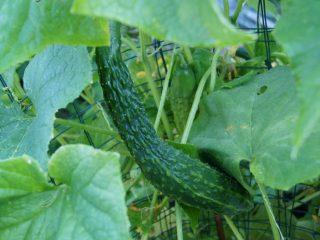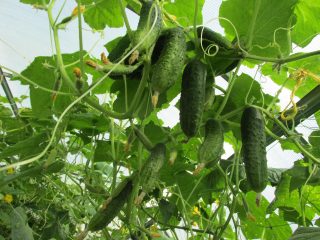Content
Cucumber Liliput F1 is an early ripening hybrid, bred by Russian specialists from the Gavrish company in 2007. The Liliput F1 variety is distinguished by its high taste, versatility of use, high yield and resistance to many diseases.
Description of the Liliput cucumber variety
Cucumbers of the Liliput F1 variety are distinguished by medium branching and a tendency to form determinate lateral shoots; the bush forms independently. The leaves are medium sized, color varies from green to dark green. Flowers are of the female type; the ovaries are borne in the axils in bunches of 3-10 pieces. In the author's description, Lilliput cucumbers are listed as parthenocarpic, that is, not requiring pollination by insects. This solves many problems when growing cucumbers indoors.
Fruit growth is slow, this is genetically determined.If you do not remove the cucumber from the vine in time, it retains its length within 7-9 cm and begins to slowly grow in width, does not turn yellow for a long time, but the growth of new ovaries is greatly inhibited.
Description of fruits
A brief description of the variety and photos of Liliput F1 cucumbers can be found on the seed packaging. Zelentsy have an elongated cylindrical shape, sometimes growing in the form of a truncated cone. The skin of the Lilliput F1 cucumber is thin, even in overgrown specimens, and has a rich green or dark green color, gradually lightening from the base to the top. Short white streaks can be seen on the surface of the peel. The cucumber is smooth, with many pimples, in the middle of which there are small whitish spines. These small needles break off easily when collected.
It’s easy to guess the size of Liliput F1 cucumbers from the name of the variety. The average specimen does not exceed a length of 7-9 cm, 3 cm in diameter and a weight of 80-90 g. Pickles are collected daily, gherkins - every other day. Zelentsy tolerate transportation well and do not lose their presentation and taste for a long time.
Liliput F1 cucumbers are hard and crispy, have an excellent delicate taste. They are good fresh, as part of salads and other cold appetizers. The Liliput F1 variety does not accumulate bitterness (the substance cucurbitacin is not produced) under sudden temperature changes and unstable weather conditions. Liliput cucumbers are an ideal option for winter preparations (pickling and pickling).
Main characteristics
The work on creating the variety was carried out by breeders Shamshina A.V., Shevkunov V.N., Portyankin A.N., it is they, along with Agrofirma Gavrish LLC, who are assigned the authorship. Liliput F1 has been listed in the State Register since 2008.
The variety is recommended for cultivation in protected ground (greenhouses, hotbeds) on private farms, however, it is also successfully grown in open ground. Lilliput F1 is zoned in the Northern, Northwestern, Central, Central Black Earth, Middle Volga, Volga-Vyatka and North Caucasus regions.
Productivity
Liliput F1 cucumbers produce a stable harvest even with prolonged rains, short droughts and other unfavorable weather conditions. The growing season of Lilliput is short: 38-42 days pass from the first shoots to a mature cucumber. This hybrid is characterized by high yield; 10-11 kg of cucumbers can be harvested from 1 m² per season.
The main factors that increase the yield of any variety of cucumbers:
- good seed material;
- fertile, fertilized soil;
- regular watering at the root;
- timely feeding;
- Frequent harvesting of fruits.
Resistance to pests and diseases
Liliput F1 cucumbers have high immunity to diseases such as:
- powdery mildew;
- downy mildew (peronosporosis);
- olive spot (cladosporiosis);
- root rot.
In greenhouse conditions, cucumbers are often affected by whiteflies, spider mites, and melon aphids. If pests are detected, it is necessary to immediately treat the bushes with an insecticide solution. For the purpose of prevention, it is necessary to promptly remove withered leaves and stems, as well as rotten fruits, observe crop rotation, regularly disinfect the greenhouse along with equipment, and follow all the basic rules of agricultural technology.
Pros and cons of the variety
The undoubted advantage of Liliput cucumbers over other varieties is the following positive characteristics:
- early ripening (on average 40 days);
- high yield (up to 11 kg/m²);
- possibility of cultivation in open ground and in greenhouses;
- excellent taste;
- absence of bitterness even under unfavorable growing conditions;
- versatility of use;
- excellent keeping quality and transportability;
- presentable appearance;
- resistance to major diseases;
- disinclination to barreling and yellowing during irregular collection of greens.
The disadvantages of the Liliput F1 cucumber variety are the relatively high cost of seeds and the inability to collect your own seed.
Growing rules
A rich harvest of cucumbers depends not only on the genetic characteristics of the hybrid, but also on the growing conditions of the crop. Positive reviews about Liliput F1 cucumbers, supported by photos from the greenhouse, are the result of painstaking work and the correct approach to cultivation on the part of the summer resident.
Sowing time
Cucumbers of the Liliput F1 variety can be sown directly in the beds and using the seedling method. Seeds are sown for seedlings in late April - early May. Shallow individual containers and purchased nutrient soil for vegetable crops are suitable for this. You can make your own soil mixture by combining garden soil with store-bought soil in a 1:1 ratio, and adding a little sand and vermiculite.
Cucumber seeds without pre-treatment are placed in the soil to a depth of 1-1.5 cm, the containers are covered with polyethylene and placed in a warm place with a temperature of 20-22°C; when seedlings appear, the cover is removed.At home, cucumber seedlings are grown for no more than 3 weeks; further delay in replanting will significantly reduce the yield.
When sowing Liliput cucumbers in a greenhouse, you need to focus on the temperature inside the structure. It should be at least 15-18°C. Liliput cucumbers are sown in open ground in late May - early June.
Selecting a location and preparing beds
For growing cucumbers of the Liliput F1 variety, an open, flat area or a small hill is suitable. In lowlands, cucumbers are likely to rot. The place should be sunny; even the slightest shadow can negatively affect the yield.
Compost, humus, sawdust and fallen leaves are placed in the soil for cucumbers in advance. This will increase the fertility and structure of the soil. A small amount of complex mineral fertilizers is also applied to future cucumber beds. The soil reaction should be neutral or slightly acidic; soil with a high acidity index is unsuitable for growing the Liliput F1 variety. Heavy clay soils that do not permeate moisture well will also not produce a decent harvest of cucumbers.
How to plant correctly
When planting cucumbers of the Liliput F1 variety, you need to adhere to the 50*50 cm pattern. Experienced agronomists advise not to plant bushes denser than 3-4 plants per 1 m². The optimal depth for planting seeds in open ground is 4 cm.
When using the seedling method, young cucumbers are pre-hardened by taking the containers with the plantings out into the fresh air.20-25 days after sowing cucumbers for seedlings, the bushes are determined to a permanent place. Peat pots can be placed directly into the soil; over time, the peat will soften and allow roots to grow. Plastic containers are carefully removed, tilting them slightly and being careful not to damage the root system. When planting in a bed, the top layer of the earthen ball should be at ground level. Cucumbers of the Liliput F1 variety can be buried up to the cotyledon leaves if the seedlings are very elongated.
The timing of transplantation into the greenhouse varies depending on the material from which the shelter is made:
- from polycarbonate - from mid-April;
- made of polyethylene or glass - at the end of May.
The technique for planting Liliput F1 cucumbers in a greenhouse is similar to the procedure for open ground.
Aftercare for cucumbers
The best option for maintaining the required soil moisture is drip irrigation. In the traditional way, at the root, Liliput F1 cucumbers are watered as the soil dries out, depending on weather conditions. To reduce moisture evaporation and reduce the need for regular loosening and weeding, the soil can be mulched with sawdust, pine needles, and grass.
Until the time of flowering, cucumber bushes are fed with fertilizers high in nitrogen and potassium. This will allow the cucumber to grow green mass and prepare for the fruiting period. After the first flowers bloom, Liliput F1 is supported with phosphorus fertilizers, as well as a complex of microelements.
The Liliput F1 cucumber variety does not require formation by pinching; only if there is an excess of lateral branches that create a dense weave and interfere with the penetration of light, they are removed.As the lashes grow, they need to be tied to a trellis - this will increase air circulation and make caring for the plant and harvesting easier.
Conclusion
The Liliput F1 cucumber from the Gavrish company has won the hearts of many gardeners due to its ease of care, resistance to many diseases, excellent taste and high yield. Envy-inducing photos and positive reviews about Liliput cucumbers only confirm the characteristics declared by the manufacturer.












